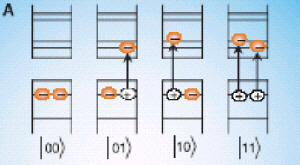Monday, July 29, 2013
coditrons and the void
"The world may instead consist of bundles of properties," says an article in the August 2013 issue of Scientific American. And an object (in object-oriented programming) is a "bundle of properties and capabilities." Theoretical physics, meet programming language theory.
And still, Democritean atomism ("in truth there are only atoms and the void") has not gone away (with atoms replaced with particles): "The application of Platonic reality to physics is fraught with problems."
Now if code describes the lowest level of reality, this level could be seen as composed of coditrons: the logic gates (some quantum in behavior) which, in combination, run the "software" of the universe. The most basic code of physics could be described as the microcode of the cosmic computer. On top of coditrons (think of them like Higgs bosons filling space) and (cosmic) microcode, the code of the universe runs.
As for the higher levels of code above the microcode, there in nothing that says that the codebases of the universe have to be completely consistent. "Paraconsistent logic has been proposed as a means for dealing with the pervasive inconsistencies among the documentation, use cases, and code of large software systems."
What we are seeing is that physics looks increasingly like it can be expressed in terms of programming language theory, microcode, codes, codebases, and even perhaps paraconsistent programming.
Sunday, July 28, 2013
preface
What could lead one to believe that the universe is a cosmic computer?
Being a coder — especially one who has written lots of code in several coding languages over a few decades — might predilect one to that way of thinking. But also it could be reflection on the observation that codes are everywhere, and everything seems to be made of them.
There is DNA's code of life, and Dr. Phil's Life Code.
I've used LaTeX/Mathematics (a language for coding the display of mathematics on paper or on a computer) for writing math. Outside of the math in one's brain code (see Jan Mycielski's "The Meaning of Pure Mathematics" on intentionalism as compared to formalism and platonism) and math written down or stored in a computer (like coded in LaTeX/Math[ematics]), that's all the places math can be. So math is made of code.
Math written in LaTeX/Math is not directly "executable" on a computer, but Mathematica comes close to being able to do that. Mathematicians may not write completely pedagogical expressions with LaTeX/Math since it is a display language, not a programming language. But when math is expressed in a programming language, it has to be exact. Whether written to display or written to execute, math is made of code.
As physics is expressed in math, physics is made of code, too.
So life is made of code, math is made of code, and everything in between is made of code.
The universe is made of code.
Saturday, July 27, 2013
the cosmic computer
This blog is not to be confused with the science fiction novel by H. Beam Piper.
The premise that our universe is a computer has several formulations, so there are several meanings to that expression. This blog will collect my own writing on what this could mean.

image from Maybe Quarterly
Subscribe to:
Posts (Atom)
